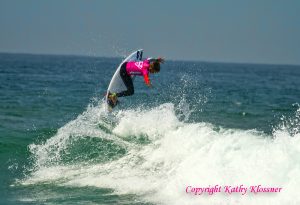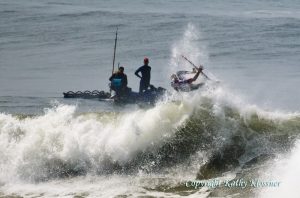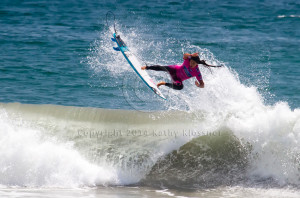This has been an ongoing debate in the sport of surfing. In most sports men have argued they are braver, stronger and faster than women, therefore, they are better than women in sports that require strength, courage, and speed. I can’t argue that there are definitely things men are better at than women, but I see the tables turning in a number of sports where women are rising and giving men a run for their money.
Back in the 90’s pro surfer, Lisa Andersen, was the top female surfer in the world. “This four-time world champion became the first woman to cross over into surfing celebrityhood,” Outside magazine wrote about Andersen in 1996, “and achieve a dominance that made the pig dudes shut up and take notice.” Surfer magazine put Lisa on their cover (the first female-surfer cover shot in 15 years) with the headline “Lisa Andersen Surfs Better Than You.” Boy, this did not sit well with the male readers. Surfer magazine got a lot of backlash for this statement. I, of course, laughed because I realized that the truth be told Lisa is a better surfer than most men.
So what defines a great surfer? Is it charging monster waves, overcoming fear and obstacles, performing aerials? Or is it the style, sportsmanship, demeanor, or being the most popular? To be the best at anything, doesn’t it require some, if not, all of these attributes?
Let’s break down these attributes and see if men and women are equal.
Riding Monster Waves: Men – Yes | Women – Yes
When you think of giant, monster surfable waves you might think of famous places such as Jaws in Maui, Puerto Escondido in Mexico, Mavericks in Northern California, Teahupoo in Tahiti, Dungeons in South Africa and let’s not forget Nazaré in Portugal. And yes, all these places have been surfed by women, with the likes of big wave surfers such as Maya Gabeira, Keala Kennelly, Sarah Gerhardt, Savannah Shaughnessy, Jamilah Star, Paige Alms, Andrea Moller and Emily Erickson. These women have charged the biggest surf breaks along with their male counterparts. It was only last year that women were allowed to compete in big-wave surfing contests. Though currently there are more men than women charging big waves, we’re beginning to see female participants increasing.
Overcoming Fear and Obstacles: Men – Yes | Women – Yes … and better
If you love to surf, then you have had to overcome some sort of fear and obstacles. But this is where I think women are better at it than men. Imagine being in close contact with a shark while surfing. Right away you might be thinking of the video of Mick Fanning’s scary encounter with a shark at J-Bay in South Africa. This horrifying experience would make the majority of us to throw in the towel, but Mick did return to competitive surfing after taking some time off after the incident. That took courage.
Now imagine losing your arm to a shark attack. Would you ever dream of wanting to go back into the ocean, let alone surf competitively with only one arm? No one, and I mean no one, cannot help but be awestruck by Bethany Hamilton. Imagine the fear she had to conquer just to go back into the water. And then to learn how to become a great surfer with only one arm, and be able to compete with the best of the best. This is pure astonishment.
Or consider perforating your eardrum from a wipeout during a surf contest and feeling dizzy, but still continuing to surf with a bandage wrapped around your head and going on to win the contest? Most of us would have had to bow out of the competition, but not Sally Fitzgibbons during the Fiji Pro in 2015. She persevered even though the odds were against her.
For most of history, women have been told again and again by society, the media and their own peers that men are just better at sports. So women never really tried to out-do men when it came to athletic endeavors. The money, the best coaches, the best equipment and the best conditions (waves) were always given to men. It was only in the last two decades, we are finally seeing equipment made for women, instead of equipment made for men but in pink. It was 45 years ago when women were finally allowed to run in marathons. It took 20 year old Kathrine Switzer to fake her entry into the Boston Marathon and shatter the concept that women were too fragile to run marathons. Even then, officials attempted to physically remove her from the race. The New York Times published that the Boston Athletic Association director Will Cloney was asked his opinion of Switzer competing in the race. Cloney said, “Women can’t run in the Marathon because the rules forbid it. Unless we have rules, society will be in chaos. I don’t make the rules, but I try to carry them out. We have no space in the Marathon for any unauthorized person, even a man. If that girl were my daughter, I would spank her.” I wonder if Mr Cloney ever encouraged his daughter to pursue sports dominated by men. You can’t argue that women have had a lot more difficult obstacles to overcome than men ever did when it came to thriving in a male dominated sport.
Performing Aerials: Men – Yes | Women – Yes
We’ve seen men doing aerials on the waves for quite a number of years. I’ve got news for you guys, women are catching up in that department too. Pro surfers such as Sally Fitzgibbons, Lakey Peterson, Malia Manuel and Courtney Conlogue are performing these great feats. I bet this list of women doing aerials on the waves is much, much bigger, but these women are the only ones I’ve seen do it with my own eyes.

Courtney Conlogue

Kelly Slater

Malia Manuel
Surf Style: Men – Yes | Women – Yes
When I watch both the pro men and pro women surfing the same waves in the same conditions I can’t help but be impressed. It’s clear the sexes have different styles, but it would be hard to say which is better. It all depends on what you as the individual finds pleasing to watch. Men use their power and strength to dominate the waves. Women use their finesse and grace to charge the waves. Two different styles, but both equally rewarding. And isn’t surfing a type of art form?
Transworld Surf interviewed Paige Alms, Courtney Conlogue and Leah Dawson and asked where they thought women’s surfing was going. Paige said “Men and women are different, and we choose the way we want to surf and how we want to portray ourselves on a wave. I just think, “Does it really matter that we choose to surf differently than men?” These women all agreed to the fact that men and women are inherently different; rather than trying to make the same expectations fit both sexes, we should be highlighting and celebrating differences. As Conlogue put it, “Surfing is an art form and an expression.” Each person sees a wave in a different way, and that’s part of the beauty of surfing.”
Sportsmanship and Deameanor: Men – Yes | Women – Yes
The pro surfers of today are wonderful role models for all generations. The camaraderie, support, dedication, and grace these surfers perform with their chosen sport are something to be proud of. Unlike the early 80’s of professional surfing where drugs and partying was the norm for the top pros, today’s pro surfers are the total opposite. The current pros, male and female, possess the dedication, training and living a healthy lifestyle to perform incredible feats that no one could ever think possible.
Being Popular: Men – Yes | Women – Yes, but better
To the surf industry, measuring an athlete’s media exposure is what gages their athlete’s contract. According to “The 2016 State of Surf” report by Transworld Business, Bethany Hamilton is currently ranking number one above her male counterparts in terms of overall audience engagement across Facebook, Instagram, and Twitter. That’s no small feat considering the career accolades of surfers like Kelly Slater and Gabriel Medina.
In addition, ten of the top 25 surfers with the highest total social engagement are women. Honoring the list are Alana Blanchard at #4, as well as Ellie Jean Coffey, Kelia Moniz, Tia Blanco, Sally Fitzbgibbons, Laura Enever, Coco Ho, Alessa Quizon, and Stephanie Gilmore.
So are men really surf better than women? It just depends on your definition what quantifies a better surfer.
